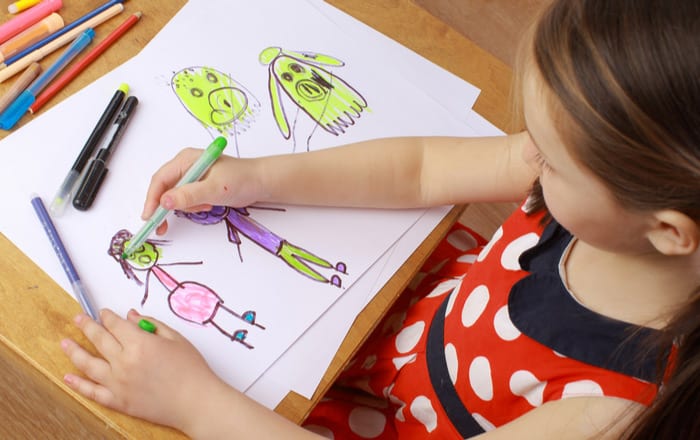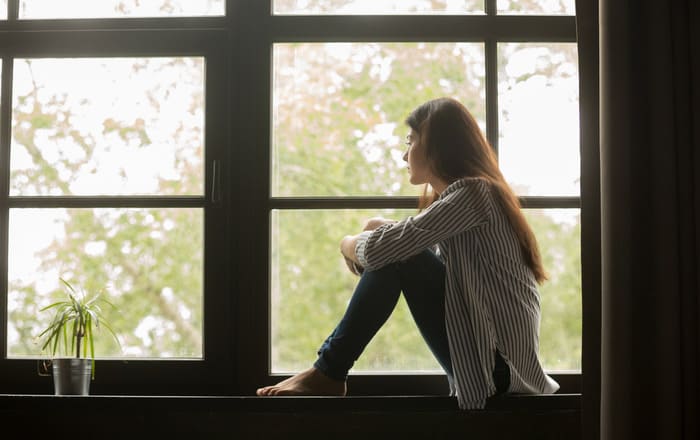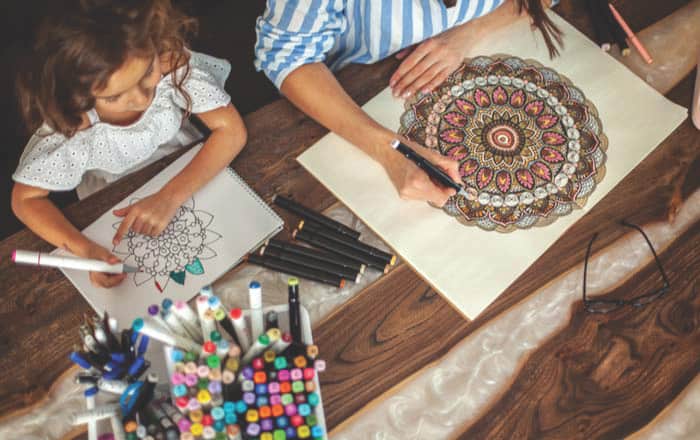While Mental Health Awareness Month occurs during May, the well-being of our youth should be a year-round endeavor. And although not every youngster and teenager lives with mental health issues, research on the pandemic effects has shown a solid connection between children’s mental health and the COVID-19 lockdown orders. Fortunately, improving students’ mental health through art therapy has emerged as a potentially viable and economical solution.
Of course, it’s not as simple as saying, “use art therapy with your children or students.” You have to first understand what’s involved in this exciting therapeutic approach. After all, sitting a child down with some markers could hardly be considered “therapy” even if it is “art.” The following guide will help you better understand how to improve students’ mental health through art therapy.

What Is Art Therapy?
Art therapy is a mental health discipline that combines creative art with psychotherapeutic techniques. Professionals take several approaches with this therapeutic offering, but the primary goal is always to improve mental health and well-being. Art therapy can promote both goals, and it can take the form of drawing, sculpting and many other mediums.
This therapeutic approach has been shown to help people with a variety of health issues. These include adults going through significant stress, children living with learning disabilities, and even individuals with brain injuries. During Mental Health Awareness Month, though, it would be folly not to mention research showing that art therapy reduces psychological distress in kids.
While art therapy is a wide-ranging field, it essentially comes down to three approaches:
- Analytic art therapy: The focus of this therapy rests upon the ideas transferred between clients and therapists.
- Art psychotherapy: The therapist verbally analyzes the artwork their clients create. The focus is on the art and its meaning.
- Art as therapy: Rather than analyzing art or sharing ideas, this approach focuses on the creation of art as the therapeutic process.
These are very different approaches, but art as therapy stands out to many parents and teachers. The idea that art on its own could provide therapeutic value is exciting. And since creating these works allows children to channel their feelings into the process, they can express things they may not otherwise communicate. While this is a benefit, it may not currently go far enough.
Art as therapy can help children express certain feelings, but it can prove difficult to foster their thought processing in a healthy way. This is why having an art therapist involved can prove so invaluable. Schools could integrate this approach into their other services to allow for long-term and consistent treatment. And since these therapists can bridge the gap between teachers and parents, everyone involved will benefit.

Why Art Therapy Is Important Now
It’s easy to assume that COVID-19 lockdown orders and a public health crisis would have a direct effect on children’s mental well-being. Unfortunately, this isn’t merely an issue where children had a hard year but will recover once things go back to normal. Even a return to normalcy once the pandemic is under control won’t really be “normal.”
The fact is that once disorders related to anxiety, depression, trauma and other issues form, they don’t go away on their own. And considering the current research on the topic, these disorders have increased exponentially during the pandemic. We saw this with an increased rate of mental health-related emergency department visits among children in 2020.
Various studies have found similar results:
- Rates of depression and anxiety in children increased by more than two-thirds.
- Youth suicide attempts and ideation rates increased during months with heightened COVID-related stressors.
- Children of families with fewer resources saw higher rates of negative mental health outcomes.
While professionals frequently use art therapy with children in clinical settings, such a professional environment is unnecessary. In fact, many students found themselves in situations where schools had become their primary or sole source of mental health support before the pandemic began. This creates a unique opportunity to integrate art therapy into traditional schooling.
More importantly, this therapeutic approach is not nearly as invasive as other mental health care settings. Even among children who aren’t having difficulties, having access to these services can prove beneficial. This is because students whose education includes regular arts programs — even without a therapeutic focus — see both social and academic benefits in the long term.
This means art has always been important, but art therapy for students may be more critical now than ever.
Benefits of Art Therapy for Students
Anyone can claim that art therapy carries significant benefits for the world’s youth, but during Mental Health Awareness Month, you want to focus on the facts. While studies show this therapeutic approach improves mental well-being in students, diving deeper into the benefits can increase understanding. This will help you see why now is the time to act.
- Helps children gain increased consciousness.
- Improve children’s social development and the ability to interact with the world.
- Assists in the development of healthy coping strategies.
- Facilitates empathy, insight and acceptance of challenges that others face.
- Improves emotional, cognitive and — sometimes — even physical development.
The sad fact is that students can feel constrained, lonely and closed off from the world even during the best times. When you factor in the effects of a society caught in the crosshairs of a global pandemic, though, it’s easy to understand why we’re seeing so many negative mental health outcomes. But with the known benefits of art therapy, we have a tool in this fight.
Art Therapy Activities for Teachers
If you’re a teacher who’s just hearing about art therapy, the potential to help your students probably has you excited. Many educators in this position feel deflated when they remember the state of school budgets. Federal school funding saw an 8 percent cut before the pandemic began, and projections show that schools may lose $57 billion because of COVID-19.
This doesn’t mean you can’t take advantage of art therapy in your classroom. The following activities can offer academic and mental health benefits.
Try Rock Painting
You want to consider the age of your students before bringing stones into class, but setting up rock painting is a great way to let children express themselves in a permanent way. Let them know you can take the stones to a local park afterward, and then check to see if there are local rock painting groups on Facebook. Your kids will feel a connection with whoever finds them!

Draw Mandalas
Mandalas are beautiful patterns that can give children something relaxing to look at. On top of this, drawing such a repeating pattern can have calming and focusing effects. For older students, these instructions on drawing a mandala will be helpful. If you have younger kids, you can find affordable and reusable stencils on a site like Amazon.

Create Art for the School Community
Help students build self esteem by inviting them to create art that will be visible to the entire school community. Work together to create a mural for the playground or encourage them to design their own student planner covers. Having a piece of artwork that is celebrated by the whole school will help students feel like they belong and that their talents are valued by all.
Create Collages
When many adults think of collages, they envision using glue sticks to paste several pieces of magazines together. While this is one option, you can get far more creative for your students. Different types of paper, fabric scraps, buttons, stickers, pasta and even masking tape are great ideas for materials. Placing different things together in alternative ways can be very calming.
Use Postcard Art Therapy
After downloading and handing out this blank postcard template, ask children to think about how they felt over the last year. Tell them they can create whatever they want on the blank side to express their feelings. Let them use a variety of materials to do this activity, and then tell them to write what they wish they could say about their feelings on the lined side. Let students know they have complete freedom and ask if any will share what they created.
Consider Photography
Art isn’t confined to painting, drawing and sculpting. Photography is an increasingly popular medium, and since many people have found anxiety relief through it, it’s a perfect art therapy option for your older students. Ask the principal for an exemption for the day if students can’t have phones in class. If they agree, take your kids around the school and ask them to take photos of what they find beauty in. Consider creating a presentation or poster featuring the images.
Design Clay Family Sculptures
Art therapists frequently ask their clients to create sculptures of their families out of clay. This creates an opportunity for discussion since the size, placement, shape and inclusion of family members can open a window into the child’s life and perceptions.
Give Art Therapy a Chance
Arts programs have seen decreased funding in recent years, but this is hardly because there are no benefits to such education. Leaders have long overlooked the importance of such a curriculum, but considering the evidence we’re seeing of COVID-19’s effects on students, allowing this to continue simply isn’t an option. Even if leaders don’t act, we must.
If you’re a teacher or a parent, it’s time to pay attention to what art therapy offers. We’re already seeing higher rates of emotional issues among children. Still, by using this therapeutic approach to overcome emotional and psychological challenges, it’s possible to help our children reach a better mental space and achieve personal well-being.